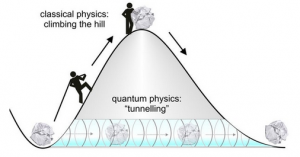In the weird world of quantum physics, it’s not unusual for particles to tunnel through barriers that under normal circumstances they shouldn’t be able to pass through. While this process, called quantum tunneling, is well documented, physicists haven’t been able to figure out if it happens instantaneously or takes a given amount of time. Now a team from the Max Planck Institute for Nuclear Physics has an answer.
The most common analogy used to explain this quirky quantum phenomenon is a ball rolling over a hill. Normally, the ball needs a certain amount of energy to push it up and over, otherwise it’s stuck at the bottom. It’s simple. But in quantum physics, there’s a chance that the ball could randomly move to the other side of the hill, through a process called quantum tunneling. This has been well documented for decades: elementary particles escaping from atoms is one of the key drivers behind radioactive decay.

The part of the process still up for debate is the timescale involved for the particle to tunnel to freedom. There are two theories: the “simple man” model says that it happens instantly, so the escaping electron will just appear at the exit of the tunnel with no velocity. But in 1955, physicist Eugene Wigner proposed the idea that it takes a finite (albeit short) amount of time for the particle to make the journey.
To investigate, the Max Planck team induced quantum tunneling of electrons in atoms, and then measured the time (if any) it took them to do so. Since it would be happening over an incredibly tiny timescale, the scientists developed a clever little trick that would allow them to see which scenario was happening.
To induce quantum tunneling, the scientists blasted a gas mixture of krypton and argon atoms with short laser pulses. This temporarily weakens the electric field that binds the electrons in place, increasing the probability that one of them will tunnel out. The trajectory of the electron’s exit from the nucleus is guided by the laser’s electric field, and in this particular experiment, the laser beam is rotating, which causes the “energy pot” containing the electrons to rotate too.
That means that the team can now settle the question by measuring the trajectory the electron takes as it zips away. Essentially, if it takes any time at all for the particle to tunnel, the energy pot will have rotated slightly by the time it exits, sending it off on a different course than if it happened instantaneously.

Using krypton and argon atoms was also key to tracking the difference in trajectory. These atoms have different barrier heights and tunnel lengths, meaning their trajectories should be slightly different if time is a factor. If, however, the tunnel time is zero, they should follow the exact same path.
Sure enough, the researchers found that time does play a role in the process. In their experiments, the electrons took between 80 and 180 attoseconds – a billionth of a billionth of a second – to make the trip, confirming Wigner’s long-standing theory.
The research was published in the journal Physical Review Letters.
Source: Max Planck Institute

